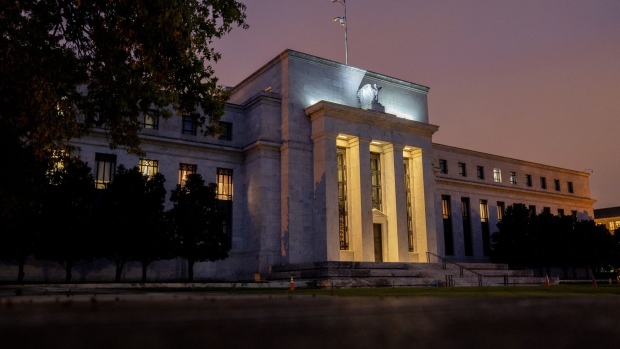Aug 5, 2022
‘Sizzling’ US Jobs Data Make Case for Bigger Fed Rate Increases
, Bloomberg News

(Bloomberg) -- A blowout US jobs report for July means the Federal Reserve will probably need to keep going with the most aggressive rate hikes in decades to curb demand and inflation, according to economists.
US employers added 528,000 jobs last month, more than all estimates, the unemployment rate fell to a five-decade low of 3.5%, and wage growth accelerated, the Labor Department said.
“The good news is people can get jobs, the bad news is that inflation remains too high and our No. 1 priority is to get that down,” San Francisco Fed President Mary Daly said Friday on Fox News.
The data add impetus for the Federal Open Market Committee to raise interest rates by 75 basis points when it meets in September, matching the moves it made in June and July as it works to cool an inflation rate that’s running at a 40-year high. The strong momentum could also suggest the central bank will need to keep rates higher for longer, contrary to market expectations for rate cuts in 2023.
The labor market is “still sizzling” and that can feed into inflation, said Diane Swonk, the chief economist at KPMG LLP. “This argues for another 75 basis point hike by the Fed.”
At a press conference last week, Fed Chair Jerome Powell said another large rate hike at the September meeting was possible, but he gave no specific forward guidance and said future increases would depend on data. Investors interpreted the remarks as a pivot to a less aggressive posture and markets rallied in response.
Fed presidents this week have strongly countered that impression, arguing the central bank wasn’t intending a pivot away from aggressive hikes and that it would take significant news to alter their posture.
Friday’s jobs data, while important, was just one of four key reports that will shape the FOMC decision next month. There will be one more employment print and two consumer-price index readouts, with the July data out on Aug. 10. That report should show slowing inflation because of plunging gas and commodities prices.
“If we get to September with things being where they are today -- and that’s a big if -- 75 basis points and signals of the risk of another 75 basis points, that’s what you’ll see,” said Mohamed El-Erian, chief economic adviser to Allianz SE and a Bloomberg Opinion contributor.
Ultimately, it’s the inflation data, which could also be affected by falling commodity prices and supply-chain improvements, that will decide the September move, said Julia Coronado, co-founder of MacroPolicy Perspectives LLC and a former Fed economist.
All else equal, the jobs data “would lean in favor of either a 75 basis-point hike or a longer hiking cycle, because we are not seeing moderating job growth,” she said.
Daly, who is not a voter on this year’s policy-setting committee, on Friday echoed remarks made earlier this week when she indicated she preferred a 50-basis-point increase in September.
“We don’t need to be too aggressive because we do already see signs of slowing,” Daly said. “Interest rates rise but it takes a while for them to move fully through the economy.”
What Bloomberg Economics Says...
“The July jobs report settles it -- we are not in a recession. More importantly, it also means the Fed will likely have to hike by another 75 basis points in September. Hiring was broad-based across sectors, and there was no evidence of widespread layoffs. The labor market has tightened even further from a high starting point. If there was any question of a dovish Fed pivot, this report has quashed it.”
--Anna Wong, Yelena Shulyatyeva, Andrew Husby and Eliza Winger, US economists
--To read the full report, click here
Yields on two-year Treasuries surged in response to the jobs report, a reflection of the expected Fed rates over that period. Market pricing indicated a 75 basis-point increase to the Fed’s key rate is now seen as a more likely outcome in at the central bank’s September meeting than 50 basis points.
Powell has described the labor market as “tight to an unhealthy level,” and has been seeking a moderation to help bring demand for products and services more in line with supplies that have been constrained by Covid-19 disruptions. He and other Fed leaders are worried about the potential for a wage-price spiral, with higher wages feeding into inflation in a cycle that is hard to break.
“This number is so comprehensively strong with a pretty significant uptick in wages,” said Mark Spindel, chief investment officer at MBB Capital Partners LLC in Chicago. “Companies are paying up for labor. Income matters most. When you look at the breadth of the employment report, and the earnings, this is an enormous tailwind for income.”
The upper bound of the Fed’s benchmark is now at 2.5%. Policy makers will have to get the target rate to the region of 4% and hold it there for some time to quell inflation and price expectations, said Randall Kroszner, a former governor at the central bank.
“You’ve really got to make sure that inflation and inflation expectations have come down and are out of the system,” Kroszner, an economics professor at the University of Chicago Booth School of Business, said on Bloomberg Television. After the jobs report, he said that a 75 basis-point increase “will be on the table for the next meeting.”
(Updates with comment from Mary Daly in third paragraph.)
©2022 Bloomberg L.P.






